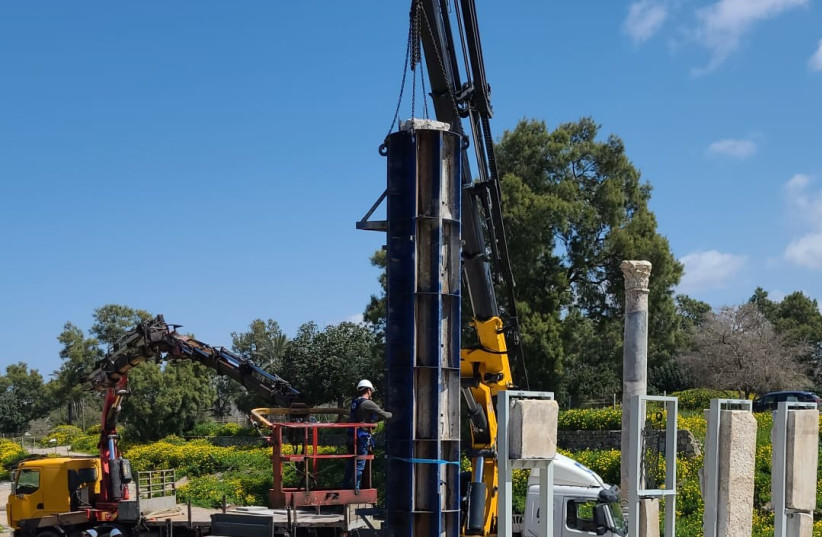Work has begun on the reconstruction of some of the 50 massive marble columns of the basilica in the Ashkelon National Park as part of an overall facelift for the park, and next week the fourth pillar will be put in place.
“It’s a very slow process and demands a lot of work not only to reconstruct each pillar but also to put them back in place requiring the use of two huge construction cranes to lower them down,” said Ronit Rozen, manager of the park.
The largest basilica uncovered in Israel, the structure is believed to have been first built during the time of Herod the Great in the 1st century CE and then underwent renovations in the 2nd and 3rd centuries CE during the Roman Severan Dynasty.
Each marble column was constructed of a monolith main shaft made of one complete piece of marble measuring almost seven meters and alone weighing about 7.5 tons, a lower pedestal and a capital on top, said Ido Rosental, the conservation architect from the Israeli Antiquities Authority who is overseeing the restoration project initiated and funded by the Leon Levy Foundation and the Nature and Parks Authority.
All told, the columns stood nine meters high, he said.

The nave, or main hall of the impressive basilica structure, measured 77 meters long and 19.7 meters wide, with the entire complex measuring 115 meters long and 34 meters wide, he said.
The reconstructed pillars are from the inner part of the nave, though there is disagreement if was an open courtyard or were covered with a roof, he said.
Rosental said they aim to reconstruct 17 of the 50 pillars.
In ancient Roman architecture, a basilica was a large civil public building with several public functions built in a central location of every Roman town usually adjacent to the forum. Later, during the Byzantine period, early Christian churches adopted the architectural structure of the Roman basilica, with a central rectangular nave flanked by two aisles and a semi-circular apse at one end, and the term came to be associated with Christian churches.
The Ashkelon basilica was destroyed in an earthquake in 350 CE, with the columns later sawed and cut for use as building materials through to the Ottoman period, so only about 10 percent of the original marble material remains.
Conservationists have taken these remains and painstakingly put them together like a puzzle, using filling material to replace the missing marble.
“Over history, the marble was sawed and used for tiles. You can see the signs of the sawing and what we have is leftovers from that. We have to connect all those pieces to make a column. Putting the columns together with these remains and placing them back is a serious technological challenge,” said Rosental.
The columns are being replaced on the pedestals in two rows. Four statues of Nike, the Roman goddess of victory, and a statue of the Egyptian goddess Isis in her Roman form have also undergone restoration and have been put back up side-by-side after centuries apart.
During Roman times the columns were kept in place due to the weight of the roof above them, holding the building in one piece, noted Rozen, but in the restoration project metal rods in a long engineering process have been put through the columns to through the pedestal and to the ground for safety.
The entire restoration and conservation project will take another year to complete, she said.
During the placement of the columns some minor excavations also revealed an additional heart-shaped corner pedestal weighing about six tons, she said.
Rosental noted that the restoration of the larger, heart-shaped corner column is a greater challenge due to the few pieces they have and its enormous weight of 17 to 18 tons.
The marble used for the columns and statues was imported from Asia Minor, so in addition to the architectural marvel of the basilica itself, it is a wonder how in ancient times the Romans were able to bring the heavy material by sea to Ashkelon, he said.
Excavations of the site were first carried out between 1920 and 1922 by the Palestine Exploration Fund based in London under the direction of John Garstang and, in addition to the pillars, also uncovered five large marble statues. After completing his excavation, Garstang decided to establish an open-air museum in the apse area to exhibit the main marbles and statues.
Over the years the museum fell into disrepair and by 2008, the walls of the open-air museum were collapsing, and the statues were in poor condition. The statues were removed for conservation. From 2008 until 2012 the Leon Levy Expedition to Ashkelon, directed by Lawrence E. Stager and Daniel M. Master, conducted additional excavations in the area. These excavations focused on the southern apse of the Early Roman Basilica and the later theatre constructed in the Severan period.
During the years 2016-2021 the main hall of the basilica and its northern part were excavated by the Israeli Antiquities Authority, under the direction of Rachel Bar-Nathan with Saar Ganor and Federico Kobrin.
“Now, one hundred years after they were excavated, (the columns and statues) are being returned to their place,” said Rozen.
